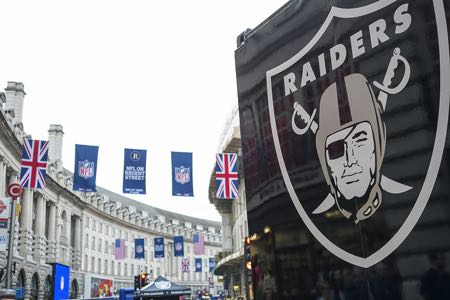
There are certain sporting events that people tune in for, even though they have little-to-no knowledge of the sport that is being placed. For horse racing, the Grand National springs to mind. In the world of golf, the Ryder Cup often captures the imagination. Even football has one, given how many people will tune in to watch the Champions League final despite not really following the sport. Yet all of those pale into insignificance when compared to the Super Bowl, which is the culmination of the American football season.
It is one of the most watched sporting events anywhere on the planet, but for British people that don’t know much about it it can seem like a mystery that is tricky to solve. For starters, Americans tend to call it ‘football’, given that it is their sport and the game that they call ‘soccer’ is much less popular in the United States than it is in Europe. Then there’s the fact that it seems a lot like rugby but with much more padding. Chuck in countless stoppages and advert breaks and people can soon feel lost. How, then, does it work?
A Brief History of American Football
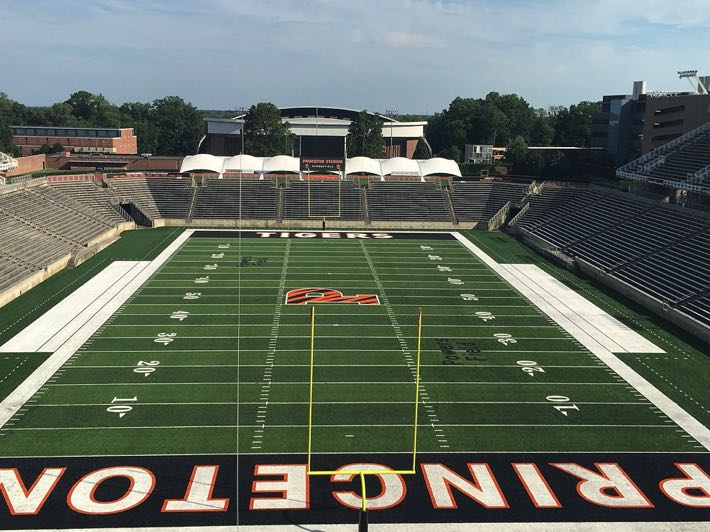
In order to get to grips with how American football works, we need to understand a small amount about where it came from. Perhaps somewhat unsurprisingly, gridiron, as it is often referred to as in the United States or America and Canada, evolved out of the British sports of football and rugby. As with rugby, two sets of teams fight for control of a ball that can be run into the opponent’s goal area or kicked between goalposts in order to score points. What is considered to be the first ever game in the sport took place on the sixth of November 1869 between two college teams, Rutgers and Princeton.
Prominent Colleges Standardise Rules
Collegiate play continued for the following few years, with the rules at play being those of the school that was hosting. In 1873, representatives from Columbia, Yale, Rutgers and Princeton met in order to come up with a set of standardised rules that would be used by everyone. One school that was missing was Harvard, who preferred the Canadian style of play over the American one. This included using an oblong ball, tackling and being allowed to pass the ball forwards. A game between Harvard and Princeton using similar rules was played in 1875, with Princeton athletes in attendance.
Intercollegiate Football Association
They liked what they saw, so it was agreed that a version of rugby with modified scoring would be played. It was a success, so Princeton, Harvard and Columbia, with Yale joining later, formed the Intercollegiate Football Association. The rules were changed and adapted in the years that followed, with Walter Camp being a major influence over the sport that we understand today. The game began the journey to professionalism in 1892 when Pudge Heffelfinger was paid $500 in order to play for the Allegheny Athletic Association against Pittsburgh Athletic Club.
The Basics of the Game
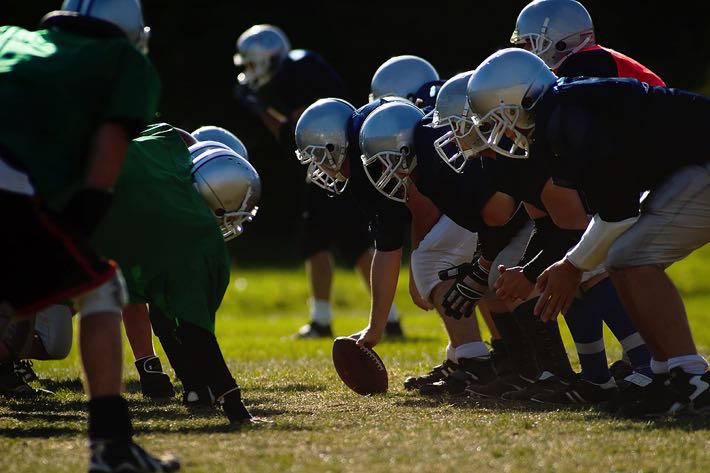
There are countless laws and pieces of terminology that you would only really understand after watching the sport for years. Rather than getting bogged down in the minutiae, the best place to start is with the basics of the rules of American football.
The Football Field
The first thing to know is that games take place on pitches that are 110 metres long and 49 metres wide, with what is known as a end zone ten yards beyond the sets of posts. As with rugby, the aim of the game is to get the ball to the opposite end of the pitch and score a touchdown.
Touchdown!
Touchdowns are scored when the ball is taken into the end zone of the opposition. That sees the scoring team awarded six points, as well as being given the opportunity to score a conversion, which is a kick of the ball between the posts worth one more point. Teams do have the choice to opt for a two-point conversion, which involves starting on the opposition’s two-yard line and trying to get the ball into the end zone again. One of the many confusing things about American football is that players don’t actually need to touch the ball down to score a touchdown.
Field Goal & Safety
There are other ways of scoring points. Field goals can be scored by kicking the ball over the crossbar of the goal, earning three points, whilst a safety is worth two points and is scored by tackling an attacking player in their own end zone.
Length
Matches take place over four quarters, each of which lasts for 15 minutes, and the team with the most goals at the end of it wins. There is a brief interval between each quarter and a longer one at the halfway point of the match. The timing is misleading, though, given the clock is stopped for several reasons during a match.
Overtime
For this reason, American football games tend to last for around three hours, rather than the one hour or so that you’d think it takes when you consider the times of each quarter. There is also the possibility of overtime, which is used in order to avoid the possibility of a draw. It is like the period of extra-time that is played in knockout football matches when a winner is needed, though it is sort of sudden death. If the first side in possession scores a touchdown they win, as does the defensive team if they score a safety.
If the first goal is a field goal, the opposition team gets a chance to score on their first possession. If they score a touchdown they win the game, whilst if it’s a field goal too then it moves to sudden death. As you might imagine, overtime rules have been tweaked and changed over the years, currently being recorded as a tie if the match is level after ten minutes in a regular season game. In the play-offs and post-season, overtime is played in 15-minute segments until a winner of the match has been decided.
Offence v Defence
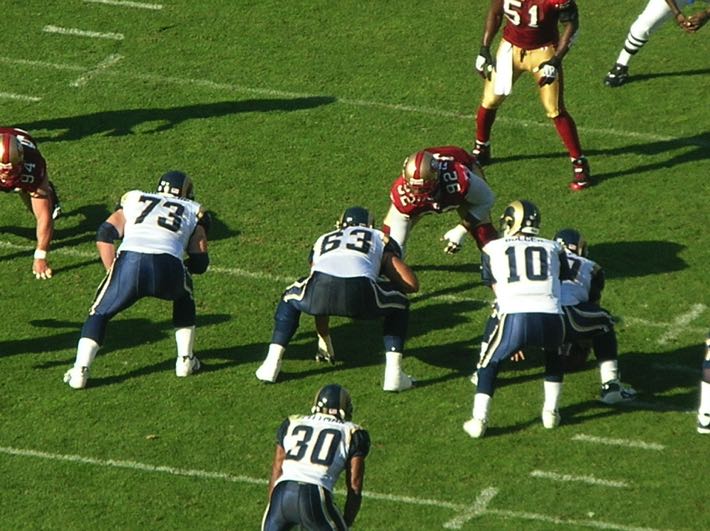
Though the Americans would write it as ‘offense’ and ‘defense’ because of their spelling decisions, it doesn’t matter how you spell it when you consider what it involves. Teams in the National Football League can have squads of 53 players, of which 46 will be in the match day team. Only 11 players will be on the pitch at any given time, but the players that make up the on-field team rotate on a regular basis. The squad is broken up into three different units: offence, defence and special teams, with unlimited rolling subs made during the course of the match.
Substitutions can only be made during a break in the play. Most matches tend to see the offence of one team taking on the defence of another. The offensive team is trying to get the ball into the end zone, whilst the defensive side is trying to stop them from doing so. When a team attacks, they have four ‘downs’ in which to either advance the ball ten yards or else score a goal. A ‘down’ is essentially a turn of moving things forward, which leads to another four downs if they succeed with one of them. How far they advance will dictate what they do.
On the Offensive
Teams that have advanced three times will often bring in their special unit in order to try to score a field goal, rather than advance another ten yards. If they’re about 35 yards from the end zone, a field goal will be tried for. Further away than that and the attacking team will ‘punt’ the ball int o the opponent’s half in order to try to gain a territorial advantage on the field. Teams that are attacking have possession of the ball, allow them to be on the offence and to attack the opposition by either running with the ball or passing it to a teammate.
The ball is only allowed to be thrown forward once per down and cannot happen if it has gone past the line of scrummage. It can be moved backwards or sideways as many times as teams want; though this method of play doesn’t happen often professionally. One of the most important players on an NFL team’s roster is the quarterback, being the leader of the team and the most important offensive player. They tend to begin the attacks, passing the ball either to a running back or to a wide receiver, depending on the play the team’s opted for.
Teams will use guards to tack opposition defenders in order to protect their quarterback where they can, giving them time and space to to execute the play that they want to. Passing tends to be the best option if a team has a large distance to cover before getting into the opposition’s end zone, whilst running will be the choice made if there is only a short distance to make it before a goal. Obviously both options are available in all circumstances, of course, with teams often mixing things up to confuse their opponents.
The Defensive Roles
There are numerous different roles to be fulfilled by the defensive team, who are tasked with the job of stopping the offensive side from advancing the ball and scoring a goal. The first job is to stop them from moving the ball the ten yards needed to advance their play, then they need to ensure that they don’t score a touchdown. When it comes to the defensive side of the game the unit is split up into three different roles, each with its own job to do in order to ensure that advancements aren’t made and points aren’t scored.
The Defensive Backs, sometimes referred to as Secondary, are players that tend to be smaller and faster, marking the wide receivers in order to stop them from getting hold of the ball. The Defensive Line is usually made up of the biggest players on the pitch, with four of them at the line of scrimmage and tasked with getting the better of the opposition players. Their main aim is to reach the quarterback before they can make their play, as well as tackle any player that is trying to run with the ball so as to stop the advance.
Linebackers, meanwhile, are something of a hybrid player that can play the two roles. They tend to be bigger than the Defensive Backs but smaller than the Defensive Line players, allowing them to be used as an extra lineman to attack the quarterback or a defensive leader to relay decisions to the rest of the team about how plays will take place. They are classed as part of the Secondary, though how exactly they will be used depends entirely on the defence that is being played by the defensive team at any given moment.
The defence also has to try to force a turnover, which is usually done by stopping the attacking team from earning its first down, forcing them to punt or attempt a field goal. A quicker way of doing this, of course, is by intercepting the ball or forcing the opposition into a fumble. If a defensive player catches the ball via an interception, they earn possession of the ball for their team, whilst an opposition player dropping the ball, known as a ‘fumble’, can lead to either team gaining possession from that point onwards.
Other Noteworthy Rules
There are other rules that are relatively easy to understand, but that you need the basic understanding of the game in order to understand. Here’s a look at some of them:
Tackling
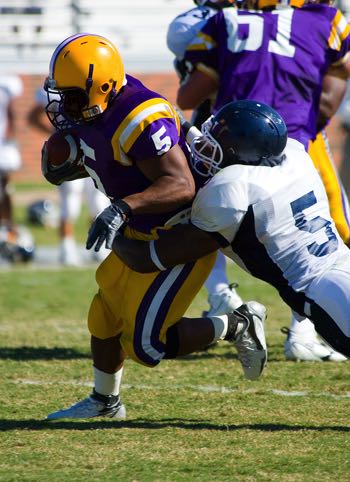 A player carrying the ball is fair game to be tackled. The interesting thing is that a receiver cannot be tackled until they have actually made contact with the ball. In other words, a receiver can advance up the field without being touched, but a talented defensive player can time their tackle for the exact moment that the receiver collects the ball. Unlike in rugby, there are a wide-range of ways in which tackles can be carried out. A player can grab an opponent’s hair or shirt, for example, as well as give them an ‘ankle tap’ to take them down.
A player carrying the ball is fair game to be tackled. The interesting thing is that a receiver cannot be tackled until they have actually made contact with the ball. In other words, a receiver can advance up the field without being touched, but a talented defensive player can time their tackle for the exact moment that the receiver collects the ball. Unlike in rugby, there are a wide-range of ways in which tackles can be carried out. A player can grab an opponent’s hair or shirt, for example, as well as give them an ‘ankle tap’ to take them down.
Traditional tackles involve wrapping arms around a player, whilst it is also fair game to just run into an opposition player and knock them down. The things that are banned are those that involve the helmet, such as grabbing an opposition player’s helmet facemask. Equally, they can’t use their own helmet to carry out a tackle. You can’t grab the padding around a player’s neck, whilst high swinging arms such as those used in the wrestling move known as the ‘clothesline’ are not permitted. Tackles are complete when the opposing player’s momentum is entirely halted.
Tackles are also said to be complete when a part of the opposition player that isn’t their hands or feet touch the ground. For a more simplistic tackle, a player can simply be forced out of bounds, which involves getting them off the side of the pitch. If any of those things happen, the down is over and play resumes with the next down. These are usually the moments when American broadcasters decide to squeeze in as many adverts as they can, whilst the clock is stopped in order to ensure that 15 minutes of actual play takes place.
Blocking is an important part of the sport, but you cannot block into another player’s back nor the backs of their legs. Blocking is a different thing from holding. Holding or grabbing any player other than the one in possession of the ball at any given moment will result in a foul being awarded against you. Blocking, meanwhile, is often used in order to stop opposition players from advancing up the pitch and perhaps being on the receiving end of a long pass from the likes of the quarterback.
Stopping the Clock
Though American football quarters are meant to be 15 minutes long, they are stopped for any number of different things. If a player is stopped, for example, then the clock is stopped. If a foul is awarded, the clock is stopped. If the ball goes out of bound… you guessed it, the clock is stopped. There are seven officials that take charge of matches, led by the referee. They use different coloured signals to indicate what’s going on, such as a yellow flag being thrown to show that a foul has been awarded for some reason.
Incomplete passes will lead to the clock being stopped, too. Both teams also have the ability to call a timeout during the game, having three per half to play with. They can call a timeout in order to rest or to discuss tactics. In something that football’s José Mourinho would love, timeouts can also be called in order to break up the play of an opposition team if they’re doing well at the time. Timeouts last for two minutes and, obviously, see the clock stopped for the duration of them so that time can’t actually be wasted by calling one.
The Road to the Super Bowl
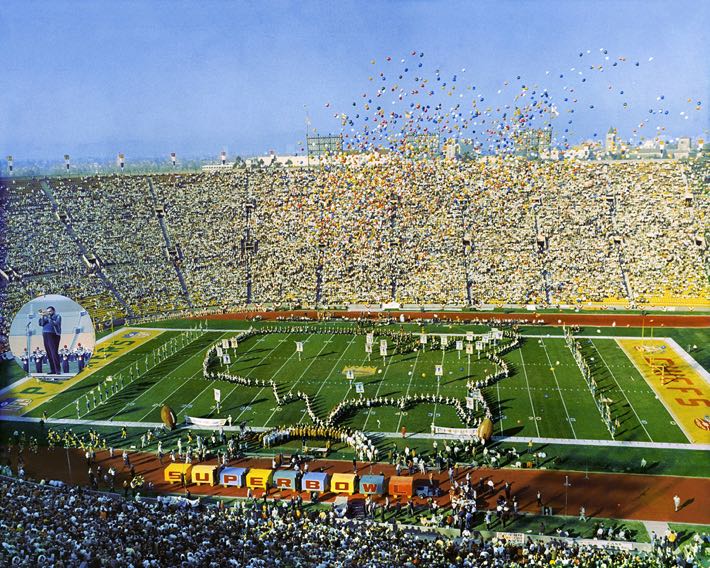
Now that we know a bit more about the rules and regulations in play during an American football match, it is worth having a look at the Road to the Super Bowl. The vast majority of British people will only tune in to watch an American football match when the Super Bowl comes around, after all. In order to understand the Super Bowl, we need to have some sense of how the National Football League works.
The National Football League
The National Football League is split into two conferences: the American Football Conference and the National Football Conference. Each Conference is then split further into North, South, East and West Divisions, boasting four teams in each. That amounts to a total of 32 teams, each of which plays 17 games over the 18 weeks of the regular season, taking place between September and January. They play each team in their division home and away, whilst the rest of the games are made up of marches against sides from their own Conference and from the other Conference. Once the regular season has been concluded, it moves to the NFL play-offs.
The Play-Offs
The play-offs is a 14-team elimination tournament, with seven teams selected from each conference. These are made up of the four Division winners as well as three wild card teams, which are all then seeded according to their overall records from the regular season. Each team that is seeded top from the Conference gets a week-one bye, whilst the other six teams take part in either the First Round or the Wild Card Round, depending on their situation. As you can imagine, the teams advance to face another side in the next round.
The Super Bowl
The Super Bowl is the final game of the NFL season. It was created as part of a merger between the National Football League and the American Football League in 1966, with the idea being that it would pit the best of the NFL against the best of the AFL. When the merger went through in 1970, the AFL became the American Football Conference and the NFL turned into the National Football Conference, all coming under the overall banner of the National Football League. Since 1971, the Super Bowl has been a match between the best team in the AFC and the best side in the NFC, with the split being relatively even.